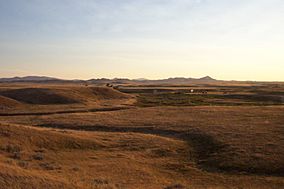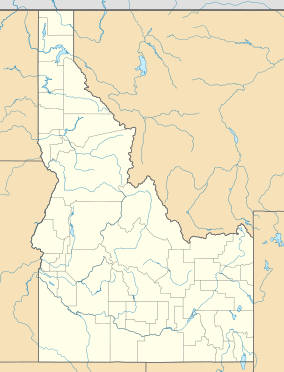Nez Perce National Historical Park facts for kids
Quick facts for kids Nez Perce National Historical Park |
|
|---|---|
|
IUCN Category III (Natural Monument)
|
|

Bear Paw Battlefield in Montana
|
|
| Location | Idaho, Montana, Oregon, Washington, United States |
| Nearest city | Lewiston, Idaho |
| Area | 4,561 acres (18.46 km2) |
| Established | May 15, 1965 |
| Visitors | 344,517 (in 2022) |
| Governing body | National Park Service |
| Website | Nez Perce National Historical Park |
The Nez Perce National Historical Park is a special place in the United States. It's not just one big area, but 38 different sites spread across four states: Idaho, Montana, Oregon, and Washington. These sites are on the traditional lands of the Nez Perce people.
The park tells the important story of the Nez Perce people. It especially focuses on the Nez Perce War of 1877. During this time, Chief Joseph and his group tried to find freedom in Canada. They wanted to avoid being forced onto a reservation. The United States Army pursued them, leading to many battles. Chief Joseph eventually surrendered in Montana.
This historical park was created in 1965. A museum opened at the park's main office in Spalding, Idaho, in 1983. The 38 sites are very different from each other. They cover various landscapes and climates. Many kinds of animals live in these park areas. Some of these animals are considered sensitive or rare.
Contents
Exploring Nez Perce History and Culture
This park helps us remember the history, culture, and stories of the Nez Perce people. It includes places linked to the Nez Perce War of 1877. This was when the Nez Perce resisted the United States' efforts to take over their lands. It also highlights the journey of Chief Joseph and his group.
The National Park Service manages the park. However, many sites are also looked after by other groups. These include federal and state agencies, as well as local communities. The main office for the park is in Spalding, Idaho. This town is east of Lewiston.
How the Park Was Created
The United States Congress officially established the park in 1965. Building the main office and museum at Spalding took some time. There were delays with getting the land and securing money from the government.
Construction finally began in September 1979. During this work, ancient Native American graves were discovered. The remains and artifacts were carefully preserved. This was done in close cooperation with the Nez Perce people. The visitor center and museum construction then continued. The museum officially opened its doors in June 1983.
Discovering the Park's Many Sites
The Nez Perce National Historical Park is unique. It's not like most national parks that are one large area. Instead, it has dozens of sites spread out over four states. These 38 sites are connected by the shared history of the Nez Perce people. They are not linked by being close together on a map.
Twenty-six of these sites are in Idaho. Many are on or near the Nez Perce Indian Reservation. You can visit many of these Idaho sites in a single day. The other twelve sites are located in the neighboring states.
Following the Nez Perce National Historic Trail
Several park sites are connected by the Nez Perce National Historic Trail. The United States Forest Service manages this trail. It follows the exact path Chief Joseph and his group took in 1877. They traveled this route when they tried to reach Canada.
Some of the important sites you can visit include:
- Battle of Bear Paw in Montana
- Big Hole National Battlefield in Montana
- Battle of the Clearwater in Idaho
- Battle of White Bird Canyon in Idaho
- Heart of the Monster in Idaho
- Old Chief Joseph Gravesite in Oregon
- Weippe Prairie in Idaho
Nature and Wildlife at the Park Sites
The many sites of the Nez Perce National Historical Park cover three main types of natural areas. These are called ecoregions. Each ecoregion has its own unique plants and animals.
Different Ecoregions to Explore
The first ecoregion is the shortgrass prairie. You can find this at sites in the Palouse grasslands and Missouri Basin. These areas are flat or gently rolling. They have rivers and streams. Their elevation is about 1,000 to 3,500 feet (300 to 1,070 meters).
The second ecoregion is the sagebrush steppe. This is found on the plateaus of the Columbia and Snake rivers. These areas are around 3,000 feet (910 meters) high. They include interesting lava fields.
The third ecoregion features conifer forests and alpine meadows. These are in the Blue Mountains, Salmon River Mountains, and parts of the Rocky Mountains. These high-elevation sites are cooler. They also get more rain than the other ecoregions.
Amazing Animals and Their Habitats
Many different kinds of animals live across the park sites. These include mammals, amphibians, reptiles, birds, and tiny invertebrates. Some of these species are very special. They are classified as "threatened," "endangered," or "sensitive" by the states.
For example, the Montana Arctic grayling and mountain plover are sensitive species. So are the swift fox, great grey owl, and boreal owl. Several fish species also need protection. You might even spot a gray wolf or a bald eagle in some areas.
Park managers work hard to protect these animals and their homes. They deal with issues like invasive plants. These plants can take over and harm native plants. They also work to reduce the impact of human activities on animal habitats. Protecting endangered species is a top priority. The park also considers the effects of climate change on its natural areas.
See also
- National Parks in Idaho



